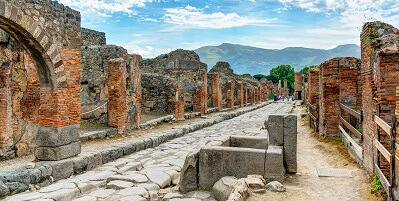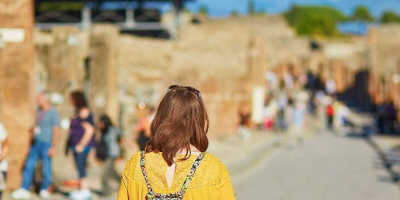What events were held in Pompeii’s Amphitheatre?
Situated in the south eastern corner of the city stands Pompeii’s amphitheatre dating back to 70 BC, and one of the few survivors of Mount Vesuvius’s eruption.
Before it’s tragic demise Pompeii was a thriving city full of bustling streets and spectacular buildings. One of the most iconic landmarks is Pompeii’s Amphitheatre, listed as the oldest remaining amphitheatre in the entire world. It’s impressive and grandiose construction is still visible today, despite its deterioration over hundreds of years.
The Amphitheatre’s Birth
It was built in 70 B.C. and was the first known amphitheatre to be made of stone, instead of wood. It was constructed by two of Lucius Cornelius Sulla’s commanders, named Marcius Porcius and Quinctius Valgus, and was built at his own private expense. The amphitheatre became the most iconic structure to the Pompeii people, which can be confirmed by it being the first building to be restored after the city’s destructive earthquake in 79 AD.
The Amphitheatre’s Construction
In contrast to later amphitheatres (most notably, the Colosseum), Pompeii’s is very simple and is an excellent example of the earliest style of an amphitheatre. Its arena was a pit excavated 6 metres below ground level with earth from the excavations heaped up into the embankments that served as seats for the spectators. This is already a clear comparison between this amphitheatre and later ones. There was a huge lack of external structures, with the arena being built on solid ground, and without underground vaults or cells for the containment of gladiators or animals which can be found in later amphitheatres. External staircases built into the walls were the earliest access ways to the seating areas which were initially wooden before being replaced by internal corridors. Considering the size of the amphitheatre, it might also come as a surprise that the arena only had two entrances. First, the Porta Triumphalis, which was used for the opening procession of gladiators, and second, the Porta Libitinensis, which was used as an exit point for the dead.
The Amphitheatre’s Capability
Pompeii’s amphitheatre was once capable of holding up to 12,000 spectators, with some historians even hypothesising 20,000. Capable of sitting not just the Pompeii citizens, but nearby towns. Many believe it was used as a model for many amphitheatres built in Rome afterwards. But it differs to other Roman amphitheatres by not having an underground section. Changes were made to the building in time, whilst some features remained the same. The south and east sides of the structure were contained by the city walls which were joined by purpose-built retaining walls to enclose the north and west. The advancements made to the structure go some way in revealing how the amphitheatre was a central part of Pompeii life. As does the area surrounding the amphitheatre which developed with taverns and eateries to provide pre and post game refreshment.
The Amphitheatre’s Purpose:
The amphitheatre was an attraction that all classes could enjoy, letting ordinary and high-class people watch spectacular performances together as one. Hosting circus shows, animals hunts, and numerous types of battles. With 35 rows of seats, the amphitheatre could accommodate up to 20,000 people. And despite all classes attending distinction remained with their separation into three different areas of the arena, with the rich in one section and the poor in another. Here are some of the most common performances in amphitheatre’s events.
-
Chariot Racing
One of the top sports of the time, Chariot Racing involved multiple horses drawing a small carriage fit for one standing driver. Racing much like modern day car racing, chariot differs in high levels of violence and cruelty. The fierce race was notorious for death and injuries, with common crashes leaving both horses and humans hurt. With the audience divided only by a 2-metre baluster, they had little protection against any unfolding action in the arena.
-
Gladiator fights
The iconic Gladiators of Rome was one of the most popular events in Pompeii. Each battle ensured a different stage of fights. With lightly armed fighters, the heavily armed and the gladiator style fights. It was a brutal display of violence with the crowd screaming for blood. It was common for dead or injured fighters to be dragged to the side after they were defeated to make room for the next fight. As we know from Rome and its Colosseum, gladiators could receive fame and glory if they fought well. As shown by the external walls of the amphitheatre which were covered with posters praising the gladiators and recording the outcome of the contests.
-
Animal Hunts
Roman people were renowned in purchasing exotic, wild animals to use in their animals’ hunts. The display of the animals altered, sometimes being dangerous leopards or tigers, or sometimes being fragile peacocks or zebras. First, they were presented to the crowd, listing their characteristics and danger. Followed by the hunting of the less dangerous animals within the arena. Afterwards, man on animals’ fights commenced, with gladiators fighting with large beasts.
Repairs were made to the amphitheatre in 62 AD with a new seating area constructed, brick supports added to strengthen the tunnels and the baluster surrounding the arena painted with bright panels depicting gladiator battles. Unfortunately, these efforts were wasted on the city, when, a few years later Mount Vesuvius erupted. Luckily, like much of the city, the eruption did not completely destroy the amphitheatre, but buried it in volcanic debris, ultimately protecting it. With the uppermost parts being the exception as they remained partially exposed up until the middle ages, and therefore show the most damage.














